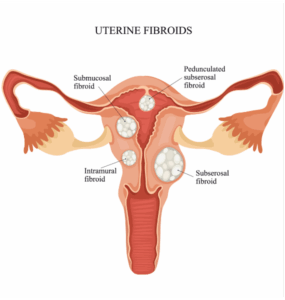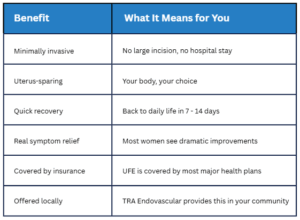When Your Body Doesn’t Feel Like Yours: Understanding Uterine Fibroids and a Gentle Path to Relief

“Is this just how it’s going to be now?”
If you’ve found yourself asking that question—month after month of heavy bleeding, missed work, canceled plans, fatigue that feels bone-deep—you’re not alone. And more importantly: this is not just your new normal.
Millions of women silently carry the weight of uterine fibroids. These benign tumors aren’t life-threatening, but the way they can derail your health, your energy, and your joy? That’s real. And it’s often dismissed or misunderstood.
At TRA Endovascular, we see you. We hear your story. And we want you to know there’s a different path forward—one that doesn’t involve major surgery or losing your uterus.
What Are Uterine Fibroids?
 Uterine fibroids are non-cancerous growths that develop in or around the uterus. They’re incredibly common—by age 50, up to 80% of women will have fibroids.
Uterine fibroids are non-cancerous growths that develop in or around the uterus. They’re incredibly common—by age 50, up to 80% of women will have fibroids.
For some, fibroids go unnoticed. But for many others, they bring:
- Heavy, prolonged periods that soak through clothes or keep you near a bathroom
- Pelvic pain or pressure that feels like a weight you can’t shake
- Bloating or an abdomen that looks months pregnant
- Fatigue that drains your energy long before your day is done
- Painful intimacy
- Urinary frequency or constipation
This isn’t just a list of symptoms. It’s a slow erosion of your quality of life. It affects how you show up at work, with your family, in your relationships—and for yourself.
“My doctor said I need a hysterectomy. Is that my only option?”
No. And you deserve to know that.
Many women are surprised—and relieved—to learn about Uterine Fibroid Embolization (UFE). It’s a minimally invasive procedure that shrinks fibroids by cutting off their blood supply. Your uterus stays intact. Your recovery is short. And for most, the symptoms improve significantly or disappear altogether.
Why Consider Uterine Fibroid Embolization?

What to Expect from the UFE Procedure
We know medical decisions can be overwhelming—especially when you’ve been suffering for so long. Here’s what the process looks like with us:
Step 1: Consultation and Imaging
You’ll meet with one of our interventional radiologists who specializes in fibroid care. We’ll talk about your symptoms, your goals, and your options. If UFE is a fit, we’ll order imaging (usually MRI or ultrasound) to map out a treatment plan.
Step 2: The Procedure
-
Done through a tiny incision in your wrist or groin
-
Takes about an hour
-
You’ll be awake but sedated
-
We block blood flow to the fibroids using small particles
-
Most patients go home the same day
Step 3: Recovery
-
You’ll rest for a few days
-
Some cramping, fatigue, or low fever is normal
-
Within 1–2 weeks, most patients return to regular activities
-
Over the next few months, your fibroids shrink and symptoms improve
Who Is UFE For?
UFE is ideal for women who:
-
Want relief from fibroid symptoms
-
Prefer a non-surgical option
-
Want to keep their uterus
-
Aren’t planning immediate pregnancy
Even if you’re not sure what your next step should be, talking to our team can help you get the answers you need.
You Don’t Have to Keep Quiet About This
You don’t have to suffer through another cycle. You don’t have to keep explaining away your fatigue or worrying about your next period like it’s a storm on the horizon.
You can feel like yourself again.
And we can help.
TRA Endovascular offers Uterine Fibroid Embolization close to home, with expert care and a team who truly listens.
📞 Call today to schedule a consultation: 253-284-0841
🌐 Learn more at www.tranow.com/endovascular
Additional Resources:
TRA Endovascular – Uterine Fibroids
